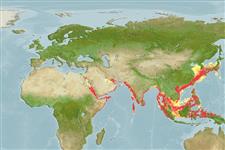Classification / Names
Common names from other countries
Main reference
Size / Weight / Age
Max length : 220 cm TL male/unsexed; (Ref. 559); common length : 80.0 cm TL male/unsexed; (Ref. 3397); max. reported age: 15 years (Ref. 72462)
Environment
Marine; freshwater; brackish; demersal; oceanodromous; depth range ? - 800 m (Ref. 100719), usually ? - 300 m (Ref. 9942)
Climate / Range
Subtropical, preferred 28°C (Ref. 107945); 47°N - 4°S, 30°E - 143°E (Ref. 54598)
Distribution
Short description
Dorsal
spines
(total): 0;
Anal
spines: 0;
Vertebrae: 145 - 159. Snout long; eye diameter 2-2.5 times in snout length; posterior nostrils much closer to eyes than to anterior nostrils; mouth very large; teeth generally large and conspicuous (Ref. 4832). Head broader, interorbital about 8 times in head; lateral-line pores before anus 44-47; dorsal-fin rays before anus 66-78; vertebrae 145-159 (Ref. 9830).
IUCN Red List Status (Ref. 115185)
Threat to humans
Harmless
Human uses
Fisheries: highly commercial; aquaculture: commercial; gamefish: yes; bait: occasionally
More information
Common namesSynonymsMetabolismPredatorsEcotoxicologyReproductionMaturitySpawningFecundityEggsEgg development
Tools
Special reports
Download XML
Internet sources
Estimates of some properties based on models
Phylogenetic diversity index
PD50 = 0.6250 many relatives (e.g. carps) 0.5 - 2.0 few relatives (e.g. lungfishes)
Trophic Level
4.4 ±0.67 se; Based on food items.
Resilience
Low, minimum population doubling time 4.5 - 14 years (Assuming tm>=5)
Vulnerability
Very high vulnerability (77 of 100)
Price category
